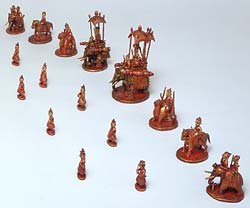Go, too, represents an equally significant departure from what preceded it. Outwardly simple, with rules that can be grasped in a short time, the game is possessed of complexities that can take a lifetime to master, if at all. Go is essentially different from chess in its concern with the mastery of territory. Its best players have been bestowed with high social standing. Both chess and go share an intellectual status that distinguishes them from all other games played with pieces on a board.
| War and Territory | 
|
||||||||||
|
War
and Territory
The advent of chess marked a major step forward in the evolution
of the board game in society. In shrugging off the dependence on
dice and developing a complex form of competition that echoed the
reality of war, chess offered new possibilities for struggle in
miniature. The player depends on nothing but his own skill and ability.
He is put in charge of a complex range of pieces and pitted against
an opponent with a matched arsenal. His job is to surround or conquer
the enemy king. Remarkably, the game stops short of regicide, but
this polite convention does not disguise the nature of the contest.
The worldwide distribution of the game, the undiminished enthusiasm
with which it is played, and the continued improvement of even its
highest exponents are all testimony to its unique qualities.
|

Chess set |
||||||||||




